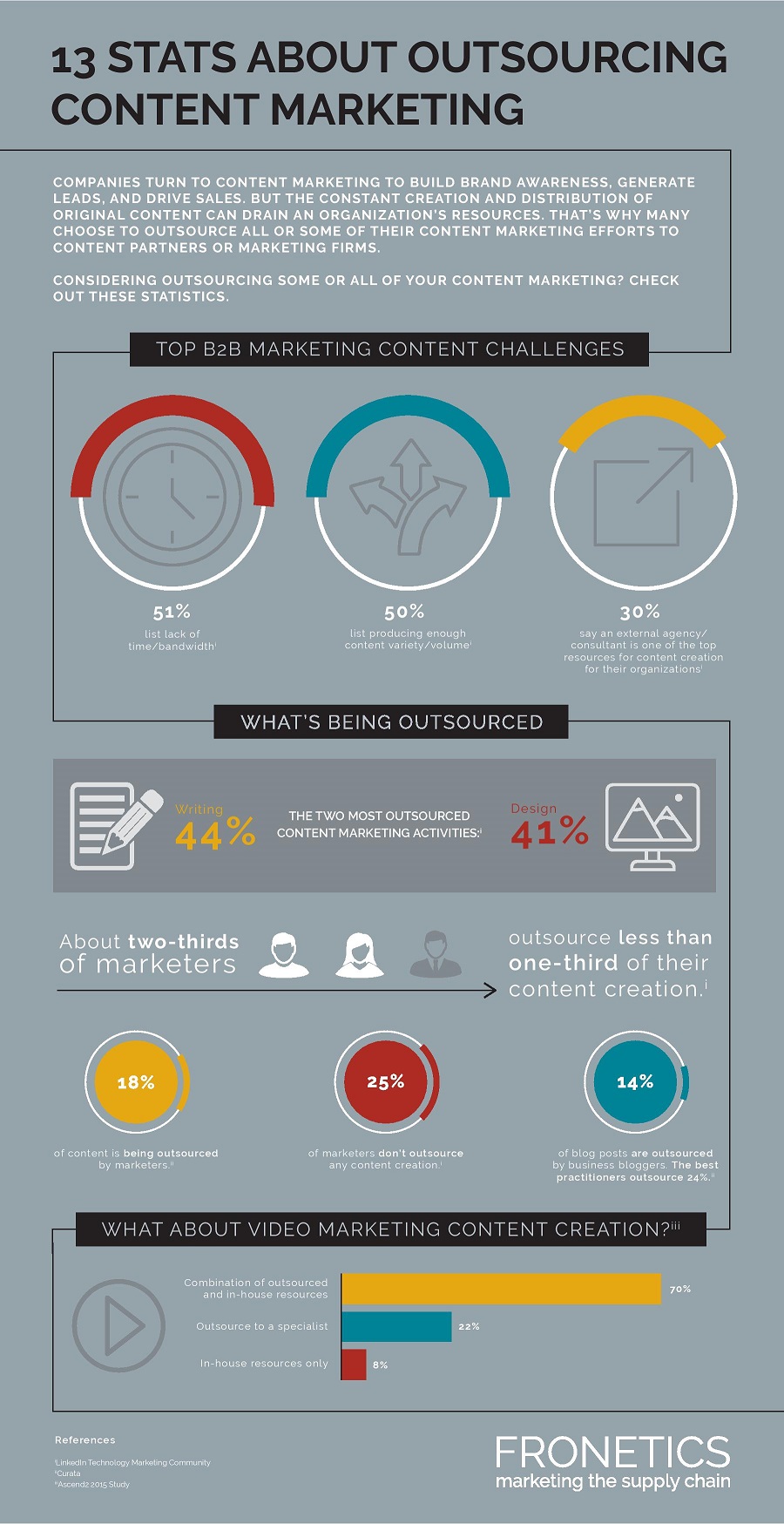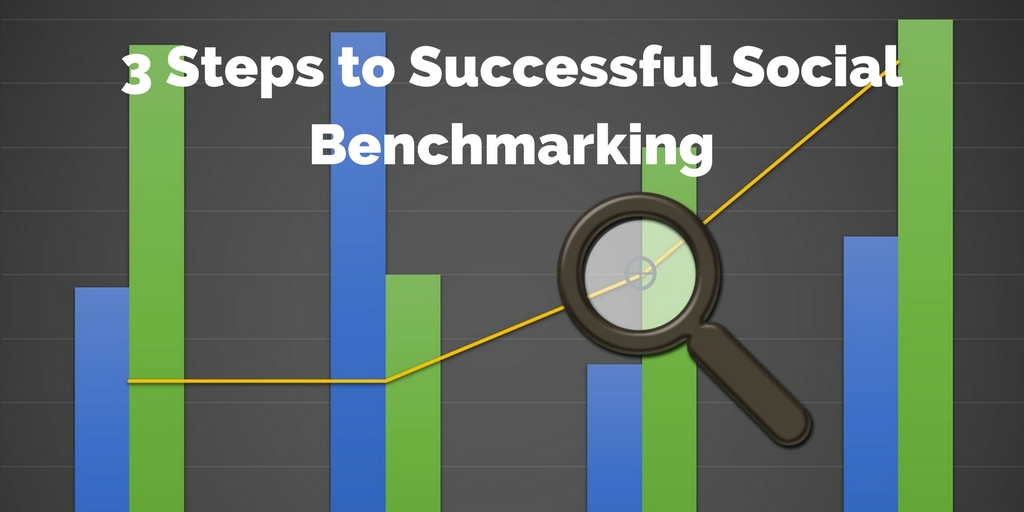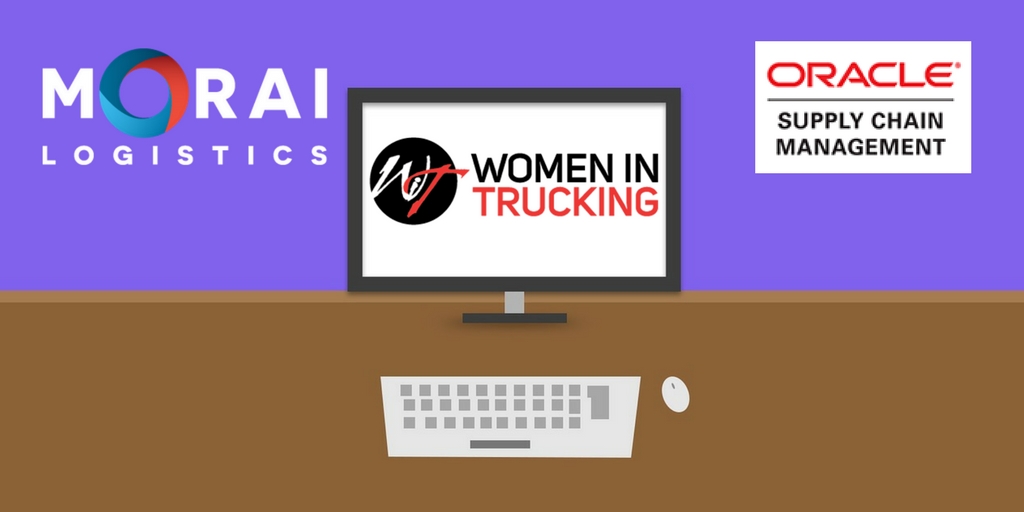
by Fronetics | Feb 7, 2017 | Blog, Content Marketing, Manufacturing & Distribution, Marketing, Supply Chain
Here are four key takeaways from the manufacturing content marketing report.
The Content Marketing Institute (CMI) has released the results of its annual manufacturing content marketing survey, and there have been some big changes since last year.
Like many businesses in the logistics and supply chain industries, manufacturing companies have been slow to adopt modern marketing principles. Many are hesitant to undertake a content marketing program, whether from lack of time or lack of knowledge about how it works and the benefits.
But that is beginning to change. Manufacturing companies are realizing how much there is to gain from inbound marketing strategies. They’re practicing content marketing, and it’s paying off. In fact, CMI has been conducting the survey among manufacturing operations for the last four years, and never before have the results indicated such progress.
We’ve summarized four of the things you need to know.
4 takeaways from the CMI manufacturing content marketing report
1. Marketers are improving at content creation.
Compared to one year ago, 59% of manufacturing marketers report more success with content marketing for their organizations. A whopping 82% of that group credits this increased success with improved content creation. This means that marketing professionals are getting more efficient at producing higher-quality content.
Related resource: Check out our guide on writing good content.
2. A documented strategy gets results.
This year’s study showed a 72% increase in companies’ documenting their content marketing strategy. Documenting your strategy allows you to set goals, identify benchmarks, and follow through on your objectives. It’s also easier for your organization to come together with a unified, well-rounded marketing and sales strategy.
Related resource: Start crafting your strategy with our content strategy template.
3. Content marketing is becoming a greater priority.
It may seem obvious, but for greater content marketing success, your business must prioritize your content marketing efforts. Of marketing managers who reported increased success last year, 62% credit putting content marketing higher on their priority list. This means communicating with leadership to ensure ample time to produce quality content.
Related resource: Show your bosses these 6 marketing metrics they really care about.
4. Manufacturing marketers are becoming more seasoned with content marketing.
The manufacturing world is gaining experience with content marketing. According to CMI’s survey, more than half (56%) of respondents report that their organizations’ content marketing maturity level is either sophisticated, mature, or adolescent — as opposed to young or “first steps.” That’s an 8% jump from last year. Gaining experience creating, documenting, and implementing a strategy is what ultimately allows marketers to determine what works for their business — and to see sustainable success.
Related resource: See how companies in the logistics and supply chain industries are using content marketing.
Going forward
CMI identified some areas for improvement for manufacturing marketers. Consider these recommendations as goals for your business as 2017 progresses:
- Fully commit to content marketing. It’s time to go all in.
- Focus on clarity in setting goals and documenting results.
- Have a real vision of what success means for your business.
Manufacturing operations have come a long way in the past year with content marketing. As the supply chain industry gets more and more comfortable with this kind of marketing, the possibilities for business development continue to grow.
Related posts:

by Fronetics | Feb 6, 2017 | Blog, Content Marketing, Marketing, Social Media, Supply Chain
Instagram Stories offer an on-trend platform for delivering targeted content to B2B buyers and building brand awareness with potential customers.
If you haven’t considered using Instagram as part of your social media marketing program, it might be time to change your mind.
As of December 2016, Instagram had over 600 million monthly active users, about half of whom are between the ages of 18 and 29. Why should supply chain and other B2B marketers pay attention to the social networking preferences and behaviors of millennials? Because 73% of millennial workers are involved in decisions to purchase products or services for their companies. Welcome to the new generation of B2B buyers.
What’s more, Instagram’s recently launched feature, Instagram Stories, offers marketers a new platform for content delivery that is wildly popular with this generation. But unlike other networks with short-term video-sharing opportunities (ahem, Snapchat), Stories can have a polished, professional feel that well suits B2B brands.
What are Instagram Stories?
Instagram Stories are sequences of content that a user posts to his/her Instagram account over a 24-hour period. Besides photos, Stories can include videos, live and prerecorded, as well as Boomerangs, seconds-long motion clips that play forwards and backwards. The content plays as a continuous feed, creating a narrative about the user’s day — hence the term “Stories.”
Users may also customize their Stories with various design tools. Swipe to explore different filters, or add customizable stickers with time, weather, location, or even holiday greetings. You can also use a drawing tool to create your own masterpiece on your photos or videos.
Audiences can view the Stories of the users they follow within the 24-hour window after they are posted. They can find users with active Stories by scrolling the user icons at the top of the app. Or users can tell their followers that they’ve posted a story by tagging them, which notifies them through a direct message.
How you can supply chain and B2B marketers use Stories?
Instagram Stories aren’t just for friends showing friends what they’ve been up to. They’re a creative content-delivery platform that helps build rapport with followers, grow brand awareness, and educate potential buyers.
Here are 5 ways marketers might use Instagram Stories to engage their target audiences.
1. Deliver special offers and limited sales
Take advantage of this channel of communication to give special offers to followers tuning into your Stories. The time sensitivity of the 24-hour period will urge your buyers to engage with your Story and act quickly before the offer expires.
Direct followers to a special landing page or include a code right in the Story. As Social Media Examiner puts it, “The scarcity of Instagram Stories gives them power.”
JCrew’s promotion of the new Jane in Pink sunglasses offers an example of the clever use of Instagram Stories. The brand posted a combination of GIFs and photos teasing the pink sunglasses before announcing that there were a mere 50 pairs available for purchase through a link in its bio. This caused half of the merchandise to sell out in two hours.
2. Sign in for a takeover
Arrange to take over the Instagram account of a partner company or customer. It’s a fun way to draw attention from an existing, built-in audience. And it provides a mutually beneficial exchange of value for both parties.
As explained by media executive Gary Vaynerchuk, account takeovers offer a “backdoor approach to accessing new demographics.” The strategy is about “deepening relationships, gaining exposure, hacking distribution, and raising awareness.”
What’s more, account takeovers don’t require partners to hand over sensitive login information. Simply send your content to your partner to upload. It’s win-win situation that allows both parties to reach a new audience and share new content with ease.
3. Go behind the scenes
This is a great way to humanize your company and let you customers see and experience your brand personality. Capture candid photos of meetings. Take your followers on an adventure or an offsite task. Have a new product? Share a picture of the early designs or the production process. It’s a way to get followers excited and intrigued as to what happens behind the doors of your company.
Happy Socks, a Swedish sock and underwear retailer and manufacturer, does this well. It features videos of what’s going on in the office, birthday celebrations, and other candid moments.
4. Q&As
Get really personal with your customers by answering their questions via 10-second videos. One of Instagram’s community managers, Jeffrey Gerson, did this and found it to be a great success. This allows your viewers to feel as though they are really being heard since they are watching you talk about their questions as opposed to just reading typed answers online. It’s also a great opportunity to showcase the personalities of your employees and social media team while directly interacting with your audience.
4. At a loss? Ask your followers!
Give the people what they want — They may have some great ideas that you’d never considered. Survey your followers by posting a graphic of some options while leaving it open-ended as well. Have them respond in direct messages or comments with what they want to see from your social media. For example, Red Bull had their audience send the thumbs-up emoji in direct messages through Instagram Chat for the Story topic they most wanted to see published.
These five options provide your team with a starting point to begin exploring Instagram Stories. It’s an exciting tool to add some creativity and have some fun with your social media strategy.
Related posts:

![Outsourcing Content Marketing: 13 Stats You Should See [Infographic]](https://fronetics.com/wp-content/uploads/2024/10/outsourcing-content-marketing.jpg)
by Fronetics | Feb 1, 2017 | Blog, Content Marketing, Marketing
Thinking of outsourcing content marketing? This infographic illustrates how other B2B marketers are handling content creation.
Plan. Create. Distribute. Repeat.
Does the constant creation of content feel like a drain on your resources? Do you feel like the content you’re publishing isn’t on par with the standards of your business? Do you dread the days that you need to write a blog post or prepare a customer resource?
If any of these questions hit home, chances are you’ve thought about outsourcing.
Outsourcing content marketing can be a beautiful thing: You put the content creation, design, and even distribution in the hands of an expert, leaving you free to focus on your job. But, isn’t that cheating? (It’s not.) Are other companies doing it, too? (You bet.) Ultimately, is it a good business decision? (The top business blogs outsource about 24% of their content creation.)
We’ve created the following infographic to illustrate how other B2B marketers are handling outsourcing content marketing. Here are 13 statistics you need to know before you consider outsourcing.

(Made with Canva)
Related posts:

by Jennifer Hart Yim | Jan 31, 2017 | Blog, Content Marketing, Marketing, Social Media, Strategy
Rival IQ’s Danica Benson discusses the importance of social benchmarking and offers three steps for getting started.
This guest post comes to us from Danica Benson, marketing communications manager at Rival IQ.
Imagine you’re on a little league baseball team. You’re up to bat. You swing and hit, sending the ball far over the second baseman’s head. You take off to first, see the outfielders running to the fences, fly past second base and onto third. The center fielder overthrows the ball as you sprint toward home, kicking dirt into sky behind you. Everyone is screaming, clapping and shouting! A home run! You feel on top of the world!
No matter which league you play in, be it little league or the MLB, a home run is successful. But, what if the pitcher walked you? In little league nobody claps, screams, or cheers. The next batter comes up, and you feel bummed out. But, not necessarily in the MLB. A walk is a strategic move. You’re on base. It’s only one base hit away from scoring position. A walk has the potential to be a game-changer and is considered a success. How is this so?
The benchmark determining success is different in the MLB than in little league. It’s the same performance in both cases, but a different interpretation of success. The same idea applies when measuring your social media activity — what is considered a successful engagement rate, number of followers, or content in one industry isn’t the same as the next.
Benchmarks require context
Benchmarks are key when interpreting data. Organizations of all kinds — large corporations, small privately owned business, nonprofits, and even sports teams — need to measure their performance to see if they’re efforts are leading to success.
Key performance indicators (KPIs) like Net Promoter Score (NPS) at a company, number of clicks on a social post, or a player’s batting average tells someone a lot about what is happening as a result of their activities. But it tells them nothing in terms of whether their efforts are successful, failing, or where to focus to close up those gaps. Why? Because benchmarks are relative.
3 steps to successful social benchmarking
Establishing benchmarks relative to your top competitors, like audience size and engagement rate, are meaningful because you are comparing to others like you who are fighting for the attention of the same audience. Without context, your metrics are what we call a “so what?” metric. We have 1,500 followers on Facebook… so what? Do we need more? Is that a good amount? These numbers only mean something if you have a benchmark for comparison.
At Rival IQ, measuring digital marketing performance begins with setting competitive benchmarks. To develop an effective social media strategy, you need contextual data. Analytics are great, but not if you don’t have context to compare your data. There are a couple of ways to do this: by comparing your organization’s metrics to itself, or by keeping tabs on your competitors. Using these methods, you can compare apples to apples and see growth in your organization, as well as how well you’re doing compared to your competitors.
Step #1: Know YOUR organization’s internal benchmarks
First and foremost, get to know your numbers. Identify your metrics and compare them to how you did last month (MoM) or last year (YoY). You always want to outperform yourself, so these benchmarks give you a base to start from and allow you to see if your activities are resulting in growth. Benchmarks can help you understand where your performance has been in the past, and help you create realistic expectations for the future.
But, what do you do if you don’t have any historical data to work with because you’re just starting up your analytics? I recommend looking at industry benchmarks, which you can find on websites such as Kissmetrics and MailChimp.
Step #2: Know your competitive benchmarks
Measuring your performance against your competitors gives you business intelligence you can use to make better decisions — especially if you’re struggling to earn social media attention. It’s too easy to think that we can just type, “What’s a good engagement rate for Instagram?” in a Google search to find a benchmark that means anything. What you will find are general figures calculated using everyone who uses the platform, which is great if your target audience is everyone who uses Instagram (not likely).
Go deeper than your industry by building your social benchmarks from scratch. Hand-select your direct competitors and look at metrics, such as:
- Which social channels do they use?
- How does the content differ between channels?
- When and how often are they posting on social media?
- What type of content are they sharing? Are they posting updates, photos, videos, live video, .gifs?
- What do their engagement rates look like?
- How many followers do they have?
Setting your social marketing strategy using your own landscape of competitors will give you a realistic, attainable goal. Accurate, relevant benchmarks are the first step in paving the way toward gaining a competitive advantage.
Step #3: Track, test & tweak
Now that you’ve reviewed your organization’s performance and can measure if it’s trending upward (or not), and you have established your benchmarks relative to your competitors, you track, test and tweak.
Track performance
By tracking your performance over time, you will be able to see if your audience is getting bored with your usual posts and may need to change your tactics. By monitoring your competitors, you can learn what content works well and take advantage of opportunities they may be missing.
Never stop testing
Social media is a great place to test things out, like new ads, campaigns, copy, contests, surveys, images, etc. Secondly, they give you feedback, fast! Find out what your audience likes on social first, then learn from your wins and failures. Take what you learn about your audience on social media and apply it to other marketing activities.
Tweak for optimization
This goes hand-in-hand with testing. Once you’ve tested a few things and have identified what’s working, tweak it and test it again to optimize it. Find the sweet spot. Social media is always changing, so there will always be more work to do.
Just as with all good strategies, you have to continually measure success and adjust based on real-world results. Competitive analytics is a great way to set social media benchmarks by basing them on companies you aspire to beat. If you aren’t beating the competition, it might be time to go back to the drawing board.
Originally from the Portland Metro Area, Danica Benson migrated north to work as a marketer in the startup arena. As the marketing communications manager at Rival IQ, she’s bringing her passion to the tech world. Outside of the office, Danica spends her free time on outdoor adventures and exploring the great city of Seattle.
Related posts:


by Fronetics | Jan 31, 2017 | Blog, Content Marketing, Marketing, Social Media, Strategy
Sales teams can use social media to cultivate relationships with potential buyers, a process called social selling.
With the dawn of the social media age and the exponential increase in choices and information available to buyers, we’ve seen a massive shift in the way B2B sales occur. According to the Harvard Business Review, a striking 84% of B2B sales start not with a salesperson, but with a referral.
As outbound sales become decreasingly effective, peer recommendations are influencing more than 90% of all B2B buying decisions. So how do we make the shift from outbound sales to this new reality? One of the more popular answers is social media.
It’s likely that your organization has some sort of social media marketing strategy in place. But making full use of these platforms requires a more nuanced, well-rounded strategy than blanket social media marketing. It’s time to introduce the idea of “social selling.”
Social media as a sales tool
In a basic sense, social selling is the strategy of adding social media to the sales professional’s toolbox. This means using social platforms to research, prospect, and network by sharing curated educational content and answering questions. The key is building relationships until prospects are ready to buy.
So what’s the difference between social media marketing and social selling, and why is it important? While both are necessary to an integrated marketing and sales strategy, the former is about engaging many — with the goal of increasing brand awareness or promoting a specific product — by producing content that users will ideally share with their networks.
Meanwhile, social selling means producing focused content, and providing personal communication between the salesperson and the buyer. Again, the key is building and cultivating a relationship using social media platforms.
How to start social selling
The benefits of social selling are numerous and significant. For example, according to a LinkedIn survey, B2B buyers are five times more likely to engage with a sales rep who provides new insights about their business or industry. Social media is a powerful engagement tool, giving sales people a platform for sharing these insights.
Here are some steps your sales team can take to implement social selling.
1) Put it in your calendar.
Allot a small portion of your day for social media. It doesn’t take a big time investment to reap the benefits of regular interaction with your prospects.
2) Integrate sales and marketing.
Encourage collaboration between sales and social marketing departments, to make the most of both efforts. HBR suggests that “marketing can train salespeople in social media systems, processes, and best practices.” In addition, sales and marketing should be regularly sharing information to make sure their goals are aligned, and efforts are dovetailing. According to a study by Data Room and Marketo, “sales and marketing alignment can improve sales efforts at closing deals by 67% and help marketing generate 209% more value from their efforts.”
3) Prioritize relationship-building.
Focus your business’ ongoing efforts to building and cultivating quality relationships with prospects. This means building in time every day for personal communication. Make your prospects’ needs your priority.
The bottom line here is building and maintaining relationships. Social media — and social selling — are powerful tools for doing just that.
Related posts:

by Fronetics | Jan 30, 2017 | Blog, Content Marketing, Logistics, Marketing, Supply Chain, Transportation & Trucking
Our readers voted Morai Logistics, Women in Trucking, and the Oracle Supply Chain Management Blog as the top 3 logistics and supply chain blogs of 2017.
Every year we ask our readers to vote for the best industry blogs. The results are always interesting — there’s really a lot of great supply chain and logistics content out there, plus it’s great to see where our readers are finding value.
This year was no different. The best logistics and supply chain blogs, as named by our readers, are all new to our best blogs list. They probably couldn’t be more different, either. But all three offer consistent, high-quality content, which is key to running a successful blog.
Here are the top 3 logistics and supply chain blogs of 2017.
1) Morai Logistics
Morai Logistics Inc. is a Toronto-based third-party logistics provider representing Mode Transportation. Morai’s blog covers the most pressing issues facing the logistics industry, as well as trends to watch out for, professional tips, and career advice. The almost-weekly posts have a lot to offer, in terms of information and thought leadership, and they often include valuable (and, might we add, beautiful) visual elements like infographics.
P.S. Check out our interview with Morai Logistics’ President Kelli Saunders.
2) Women in Trucking
The Women In Trucking Association is a non-profit organization focused on encouraging the employment of women in the trucking industry, promoting their accomplishments, and minimizing obstacles. Just one vote shy of the top spot, the Women in Trucking blog — or, should we say blogs — bring to light many issues of concern to both women and men working in the trucking industry. President/CEO Ellen Voie’s blog offers thought-provoking, insight on topics from the driver shortage to recruiting women drivers. The driver’s blog — with content mostly from longtime driver and writer Sandy Long — tackles pressing day-to-day issues facing drivers, such as parking in dangerous locations, family problems stemming from job-related realities, and assimilating to trucking culture.
3) Oracle Supply Chain Management
The Oracle Supply Chain Management blog looks at how Oracle helps organizations transform their supply chains into more holistic and integrated value chains that cover the three key operational pillars: Demand, Supply, and Product. Weekly content from a number of contributors cover topics including supply chain management, events, product lifecycle management, logistics, technology, and more.
Honorable mention
These blogs received quite a few votes as well.
What blogs do you read on a regular basis? Which have the most valuable content?
Related posts:




![Outsourcing Content Marketing: 13 Stats You Should See [Infographic]](https://fronetics.com/wp-content/uploads/2024/10/outsourcing-content-marketing.jpg)




